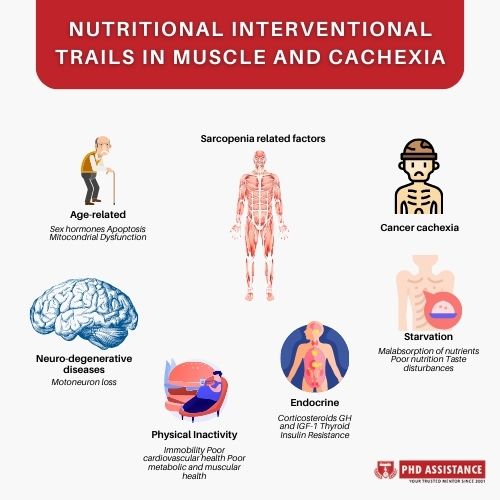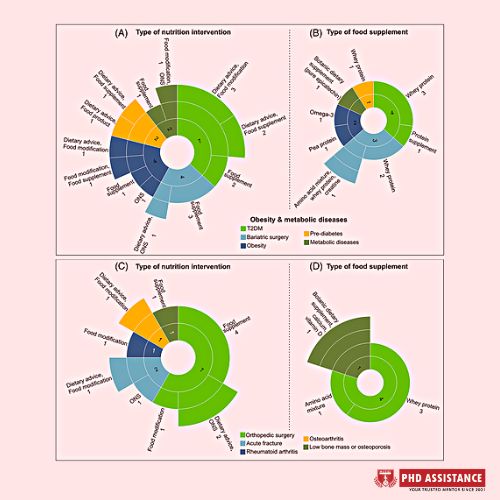Nutritional Interventional trials in muscle and cachexia PhD research directions for 2023
In brief
Muscle loss, especially alone or in the setting of sarcopenia or cachexia, is a common condition that predicts poor outcomes in ageing and illness. Research has been done to investigate the impact of specific nutrients on muscle mass or function, as appropriate nutrition is crucial for muscle maintenance. More research, however, is required to inform evidence-based decisions. This comprehensive review aimed to gather and record ongoing clinical studies evaluating dietary treatments as a strategy to prevent or treat poor muscle mass or function (strength and physical performance), sarcopenia, or cachexia. ClinicalTrials.gov and the WHO International Clinical Studies Registry Platform were searched for planned and ongoing trials through April 21, 2021. Based on the objective to investigate the effects of dietary treatments on muscle-related outcomes (i.e. muscle mass or strength, physical performance, or muscle synthesis rate) in both clinical and non-clinical Trials, randomized controlled studies with 20 participants per arm were included (i.e. ageing).
Introduction
Muscular mass loss with or without a corresponding reduction in function (i.e., physical performance or muscle strength) can happen due to ageing naturally or as a result of acute and chronic illnesses. Recent pooled analyses have shown that low muscle mass and sarcopenia (i.e., low muscle mass and function) are prevalent in community-dwelling and hospitalized older adults and patients with lung diseases, liver cirrhosis, cancer, and other diseases. However, the prevalence of these conditions may vary depending on the diagnostic criteria used. Patients may also have muscle loss without changes in body weight or even in the context of obesity (sarcopenic obesity). Cachexia is a catabolic disorder that is further defined by extreme weight loss with or without loss of fat mass and inflammation brought on by underlying conditions, with catastrophic effects on patients. Low muscle mass is one of the distinguishing criteria of cachexia(1).
Interventions
Trials were organized according to the kind of nutrition intervention, dietary guidance, food supplement, and multimodal therapies are given to participants in the experimental arm. According to the classifications provided by the European Society for Clinical Nutrition and Metabolism, nutritional treatments were classified as food supplements, food modifications, food products, fortified food products, and oral nutritional supplements (ONS) (ESPEN). The term “nutritional advise” was developed to encompass studies that offered participants dietary guidance from licensed dietitians/nutritionists or assistance from healthcare professionals, Medical research workers, or self-help resources.

Types of assessed nutrition interventions
- Dietary advice
- Food product
- Food modification
- Fortified food
- Food supplement
- Oral nutritional supplements
- Specialized oral nutritional supplements
Musculoskeletal conditions
In patients with a variety of musculoskeletal conditions, twelve nutrition trials (10.7%) were found (Figure 1). These patients included those who have undergone or are about to undergo orthopaedic surgery, older adults who are temporarily immobilized while healing from an acute fracture, and adults with osteoarthritis, rheumatoid arthritis, low bone mass, or osteoporosis. In addition, there are 40 to 400 people in the target sample size. In addition, an overview of nutritional research, treatments and food supplements stratified by musculoskeletal diseases is provided by studies that provide participants with food supplements, high-protein ONS or ONS supplemented with HMB, or food modification alone or in conjunction with dietary guidance. The critical outcomes of most trials are research methods of muscle mass, muscular strength, physical performance, or a combination of these.

Figure 1: Characteristics of interventions and distribution of trials across patients with obesity and metabolic diseases
Multiple clinical conditions
In one experiment (0.9%), 320 individuals with cancer of any kind, osteoporosis, stroke, or chronic renal disease are examined to see how dietary recommendations and resistance training affect their conditions. Muscle mass, physical performance and muscle strength are the three-month intervention’s concurrent primary objectives. However, it is unknown if the authors intend to carry out distinct analyses by illness category.
Older adults with low muscle mass or function or sarcopenia
Ten trials (8.9%) include 52–200 older people with sarcopenia or reduced muscle mass or function. Although several studies merged definitions, sarcopenia is characterized by many diagnostic criteria, such as those of the Asian Working Group for Sarcopenia, the European Working Group on Sarcopenia in Older People (EWGSOP2), or reduced muscle mass associated with poor muscular strength (HGS). Most clinical studies employ a variety of dietary supplements.
Older adults with malnutrition
One trial (0.9%) recruited 93 institutionalized older persons at risk of malnutrition or moderate malnutrition. Participants get a whey protein at lunch and a high-carbohydrate meal product at supper for 90 days. Muscular mass measurements using DXA are the primary outcome of interest, while muscle strength measurements using HGS and lower body strength tests are the secondary outcomes (using the 6MWT and TUG tests)(3).
Conclusion
This scoping review identified several current RCTs investigating the impact of dietary treatments on muscle mass, muscular function, sarcopenia, or cachexia in ageing and illness. More research is to be expected on the impact of dietary supplements and ONS including protein, amino acids, omega-3 fatty acids, or HMB on these disorders. Although many studies use the same therapies, there was methodological variation in the research design, supplement dose, duration of the intervention, and outcome evaluation, and several trials lacked crucial data. These problems or restrictions might make it difficult to compare research, pool data, or conduct upcoming meta-analyses, limiting the ability of these ongoing investigations to generate recommendations supported by the available evidence. To improve the area, PhD research offers suggestions for upcoming research studies on nutrition and multimodal treatments for cachexia, sarcopenia, and muscular health.
About PhD Assistance
Many trials have similar interventions; methodological heterogeneity may challenge study comparisons and future meta-analyses to provide evidence-based recommendations and assess the therapeutic effects of nutrition interventions. PhD. Assistance serves as an external mentor to brainstorm your idea and translate that into a research model. Finally, we deliver, What We Promise.



